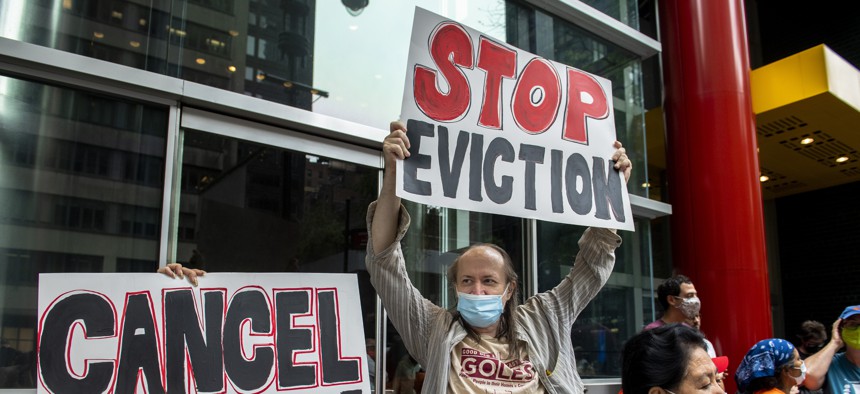Confusion Over How Latest Eviction Ban Will be Enforced

About 80% of counties are covered by the moratorium, but a change in local coronavirus transmission rates will affect eligibility.
The latest eviction moratorium issued by the Centers for Disease Control and Prevention protects renters in some counties, but not others. And it’s unclear how jurisdictions are expected to verify whether the ban applies.
That could complicate enforcement of the moratorium and allow the burden to fall on renters facing eviction to prove they live in an eligible county, policy experts said.
Unlike the previous iteration of the moratorium, which banned evictions from moving forward nationwide, the latest ban applies only in counties with a “substantial” or “high” level of community transmission of the coronavirus.
The CDC tracks community transmission rates and estimates that 80% of counties across the United States currently fall into the high or substantial categories. However, if a county’s transmission rate drops to a moderate level for 14 consecutive days, the eviction ban would no longer apply there, the CDC order states. Likewise, the moratorium could expand to other counties if the rate of transmission increases.
It’s a standard likely to sow confusion, said Caleb Kruckenberg, an attorney with the New Civil Liberties Alliance, a nonprofit legal group that has challenged previous iterations of the CDC moratorium in court.
“Who knows where it applies. The situation might change. It might apply in one county one day and not the next,” he said. “It falls to the local courts to figure out.”
Without further clarification, the burden to prove a county is eligible may fall on renters facing eviction proceedings, said Sarah Saadian, the vice president of public policy at the National Low Income Housing Coalition.
“It’s going to be challenging for renters to know whether they are protected or not,” she said.
Instead, she suggested that the landlords could be required to attest during eviction proceedings that their county is not covered by the moratorium.
The National Association of Counties wants the CDC to provide more clarity on how counties will be included or excluded from the moratorium, said Eryn Hurley, an associate legislative director at NACO. The CDC’s maps, which show county transmission rates, are helpful, she said. But the organization hopes to consult with the CDC further about how counties should go about tracking future infection rates.
“As we get a better understanding of the moratorium and who it does and does not cover, we will be able to have a better understanding of next steps,” she said.
The CDC used the same “high” and “substantial” transmission rate data to revise guidance last month on whether vaccinated individuals should wear face masks indoors. A “substantial” level of community transmission is defined as 50 to 100 new cases per 100,000 people over a 7-day period and a “high” level as more than 100 cases.
The CDC did not respond to questions Wednesday about how local governments should assess their community transmission rate or whether the center would proactively alert local officials to changes in transmission rates that would affect applicability of the moratorium.
Will the Ban Hold Up in Court?
The CDC moratorium, issued Tuesday, is in effect through Oct. 3. The previous ban was allowed to expire on Saturday after the White House acknowledged that the U.S. Supreme Court would likely find an extension impermissible.
President Biden said Tuesday that even he was unsure whether the current order would hold up in court.
"Whether that option will pass constitutional measure with this administration, I can’t tell you. I don’t know," Biden said during a Tuesday news conference. "There are a few scholars who say it will, and others who say it’s not likely to. But, at a minimum, by the time it gets litigated it will probably give some additional time while we’re getting that $45 billion out to people who are in fact behind in the rent and don’t have the money."
Congress allocated $46 billion in emergency rental assistance to respond to the economic impact of the coronavirus pandemic, approving two tranches of money in December and March. As of June, state and local governments have distributed only about $3 billion emergency assistance.
Despite the uncertainty about how the new order will be enforced, both Hurley and Saadian said the extension of the ban was critical to protect renters who have fallen behind on rent during the pandemic.
“Counties definitely welcome the extension of the federal eviction moratorium,” Hurley said, adding that the extension gives local governments more time to distribute the emergency rental assistance.
Despite the flaws in its design, Saadian said the ban ensures that millions of tenants who are behind on rent are not evicted.
“It is so important that state and local governments are using this time to really ramp up their emergency rental programs,” she said.
Andrea Noble is a staff correspondent with Route Fifty.
NEXT STORY: “I Wish It Had Not Become Law,” Says Governor Of Mask-Banning Order He Signed Into Law





